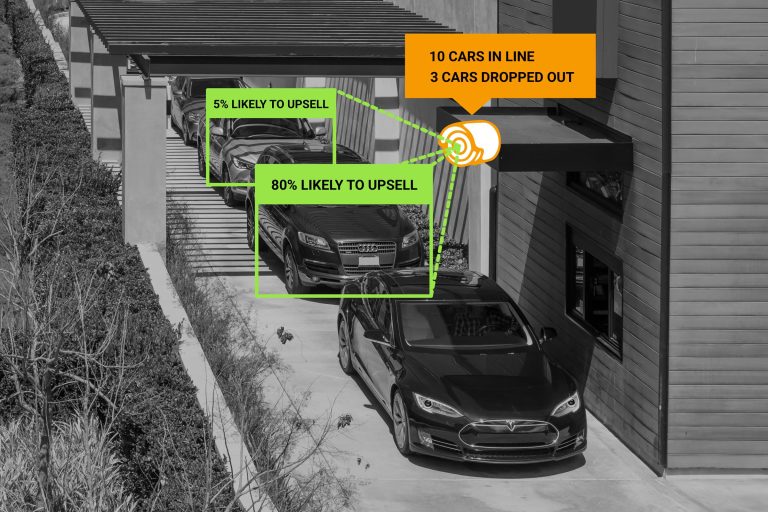The Three Things That Make a Good Fast Food Drive-Thru Great

As restaurants’ labor challenges continue, putting pressure on both table service and delivery businesses, many eateries are turning to drive-thrus to drive sales and boost margins. In fact, even those that have never tried the channel (and never thought they would) are beginning to enter the space.
“There’s a ton of press of people wanting more drive through,” Rajat Suri, founder and CEO of voice, vision and touch automated technology firm Presto, told PYMNTS’ Karen Webster in an interview. “The funny thing is, casual dining is now experimenting with drive-thrus. … It makes a lot of sense for them to have that flexibility and that option.”
He cited the examples of quick-service restaurant (QSR) Panda Express, fast-casual giant Chipotle, casual dining chain Applebee’s and even convenience retailer Wawa as major brands that previously had no designs on the channel that have recently been investing in new drive-through capabilities.
Indeed, even brands without built-in drive-through lanes have been adding curbside options for employees to bring food out to consumers in their cars in the parking lot, an experience that Presto powers with voice artificial intelligence (AI).
Currently, having just recently gone public via special purpose acquisition company (SPAC) Ventoux, the tech company is keeping its focus on “top 100, top 200” restaurant groups.
With this experience working with major restaurant brands, Suri has identified three key factors that distinguish the ideal drive-thru: “It’s personalized, it’s convenient and it’s low cost for the restaurant.”
The Personal Touch
One such factor is personalization, with great drive-thrus providing the consumers with an experience improved by a knowledge of their desires and preferences. Plus, technology to recognize a given customer can also help the restaurant drive spending, enabling the brand to, say, advertise that diner’s favorite add-on.
Suri noted that, in some states, brands are permitted to recognize customers by their license plate. In areas where this is not allowed, brands can still recognize a customer’s profile via their loyalty app.
“Of course, the person would have to opt into that,” Suri said, noting that this technology requires diners to sign up for the loyalty program or mobile app. “But once you set it up, it should be seamless.”
He noted that these features not only improve the experience for the diner who is placing the order but also for those behind them in line, reducing the time it takes that customer to go through the menu and deliberate.
Features that speed up the ordering process and that encourage consumers to engage with the brand via their own devices are especially helpful given that the vast majority of drive-thrus do not have self-service technology set up on premises.
In fact, the share of restaurants offering drive-thru lanes with self-service kiosks fell dramatically between Q3 2021 and Q2 2022, according to data from this year’s edition of PYMNTS’ Restaurant Readiness Index, which drew from a survey of more than 500 U.S. QSR and full-service restaurant managers. The share dropped from 16% in September 2021 to just 9% in April 2022.
Read more: More Than Half of Restaurants Depend on Digital Sales, Despite Uptick in On-Premises Orders
In and Out
It is fitting that one of the first restaurant brands to offer a drive-thru as we know it was California-based QSR chain In-N-Out Burger, given that getting consumers in and out efficiently remains one of the top concerns for today’s drive-thrus.
Efficiency is especially challenging for brands to manage today, with labor challenges straining their capacity and often leading to long, slow lines. These issues are compounded by the fact that if employees are overworked and consequently less satisfied with their jobs, they in turn work less efficiently, making more mistakes. Paying them more can help with satisfaction, but doing so is not always an option.
This creates something of a lose-lose for restaurants. Underpaid, overworked employees’ inefficiency can impact capacity and hurt customer satisfaction, hurting sales, but paying and hiring more can be prohibitively costly.
Indeed, the Restaurant Readiness Index found that about one in three restaurants report that their level of service has decreased as a result of staffing issues.
“That’s why this industry needs to automate,” Suri said. “They just can’t [afford] that happy service. And the good thing about the voice AI is, it can always be happy, and it can always be accurate.”
A Penny Saved
Suri noted that one factor of a drive-thru’s success that often goes under-discussed, given the difficulty of measuring it, is that of the customer’s overall satisfaction. Plus, in addition to being hard to quantify, boosting the customer experience can also be expensive for restaurant, especially with the industry’s high turnover rate, requiring extensive (and repeated) training.
“We were seeing … on Google that two thousand bucks a month or something you’re spending just on retraining people and [on] all the mistakes they make,” Suri said.
He noted that, by using automated technologies, restaurants could circumvent these training costs.
In addition to the kinds of technology in which Presto specializes — voice ordering AI, computer vision for smarter analytics and touchscreen hardware — Suri predicts that automation will also increasingly find its way into other parts of restaurant operations such as their kitchens.
“I don’t think it’s going to happen, like, next year,” Suri said, “but I think over the course of 10 years, all the different parts will be automated.”

